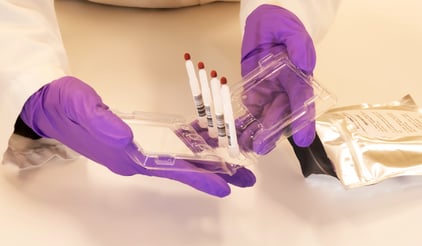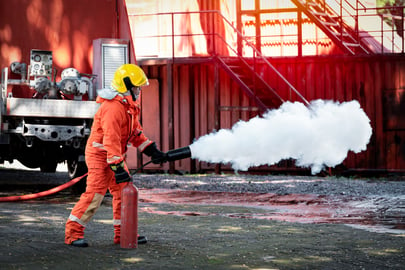Share this
measuring ‘forever chemicals’ from blood microsamples
by James Rudge, PhD, Technical Director, Trajan on Jul 31, 2023 9:00:00 AM
An article by Courtney C. Carignan, et al, at the University of Michigan, Duke University, Colorado School of Mines, and Eurofins USA, was published in the May 2023 edition of Environmental Science & Technology. They outlined the optimization and validation of a method developed at Eurofins USA to monitor environmental toxins in the form of ‘forever chemicals’ comprised of perfluoroalkyl and polyfluoroalkyl substances (PFAS). The paper is entitled “Self-Collection Blood Test for PFASs: Comparing Volumetric Microsamplers with a Traditional Serum Approach.”  The study showed excellent concordance between capillary dried blood and serum for a wide range of these chemical substances from an n= 53 volunteer cohort. The researchers highlighted the benefits of using Mitra® devices based on VAMS® technology for finger-prick blood sampling, stating that the findings indicated that Mitra was a useful tool for the self-collection of blood to assess human exposure to elevated PFAS levels.
The study showed excellent concordance between capillary dried blood and serum for a wide range of these chemical substances from an n= 53 volunteer cohort. The researchers highlighted the benefits of using Mitra® devices based on VAMS® technology for finger-prick blood sampling, stating that the findings indicated that Mitra was a useful tool for the self-collection of blood to assess human exposure to elevated PFAS levels.
What are ‘forever chemicals’?
So-called 'forever chemicals,' or Perfluoroalkyl and Polyfluoroalkyl Substances (PFAS), are a group (~9000) of organic molecules which contain fluorine atoms as essential moieties of the molecule. They are used in the manufacture of a wide range of commonly used materials. For example, due to their flame- and temperature-resistant properties, they are a key component of firefighters’ foam.
 Some PFAS chemicals also have reduced friction properties, so they are utilized in the non-stick surfaces of many cooking pans. They also provide stain resistance on clothing.
Some PFAS chemicals also have reduced friction properties, so they are utilized in the non-stick surfaces of many cooking pans. They also provide stain resistance on clothing.
While PFAS chemicals appear to be useful, there is a concern that due to their physicochemical properties, they do not break down easily, if at all. Studies show that PFAS chemicals accumulate in nature and the environment, increasing the likelihood of human exposure, and potential health issues. Indeed, a 2015 study by the Centers for Disease Control and Prevention (CDC) showed that 97% of US citizens have these forever chemicals, or PFAS, in their blood.
Health Concerns Linked to PFAS
According to the CDC, research studies suggests that high concentrations of certain PFAS chemicals may possibly lead to health concerns, such as increased cholesterol levels, changes in liver enzymes, small decreases in infant birth weights, decreased vaccination response in children, risk of preeclampsia or high blood pressure in pregnant women and an increased risk of testicular or kidney cancer.
However, it must be noted that these studies did not investigate the same PFAS chemicals or exposure types, nor did they study identical cohorts. For these reasons, a variety of outcomes have been reported. As a result, there is an interest in conducting large-scale epidemiological and related studies to monitor PFAS levels more systematically in populations.
Using VAMS for Remote PFAS Studies
One of the issues when conducting epidemiological studies to measure environmental contaminants such as PFAS chemicals, is the cost and inconvenience of collecting venous blood samples. If collected at clinics, the venous samples must be shipped on dry ice to specialist laboratories.
One solution to reducing the costs and challenges of blood sample transport is to use remote dried blood sampling in place of venous blood sampling. Dried blood samples overcome the logistical issues associated with collecting and transporting venous blood. Indeed, it is for this reason that the researchers decided to develop a dried blood PFAS assay.
The group first considered dried blood spot (DBS) sampling as it had been used widely in the past, including for PFAS studies. However, the researchers commented that there was a lack of accuracy seen with DBS due to different volumes of blood applied to the filter paper material, which impacted results. This view has been shared in the literature by many other researchers working with DBS samples.
As a result, the researchers decided to use a volumetric absorptive microsampling approach to collecting blood samples. They chose to use Mitra® devices based on VAMS® technology.
In 2018, Neoteryx co-published a study paper with the National Institute for Health and Welfare in Finland which discussed how good linearity, repeatability, accuracy, and stability had been seen for 12 PFAS chemicals using 10 µL Mitra microsamples.
Although the 2018 study demonstrated that PFAS chemicals could be successfully measured from Mitra devices, there were a number of limitations with the work that was presented. The first was the size of the device’s absorptive tip, which limited the volume that could be collected. The second limitation was the size of the cohort (n=12). A third limitation was that serum, a popular matrix for PFAS measurements, had not been collected to allow for assay bridging.
As a result, the researchers embarked on a larger study to see how Mitra would perform in a larger community-based PFAS biomonitoring study. In this larger study, their aim was to compare self-collected Mitra-VAMS microsamples paired with serum harvested from venous collection.
Methods and Findings of the ‘Forever Chemicals’ Study
- 45 PFAS chemicals were targeted for the assay; 21 of these were detected in 1 or more samples.
The samples were then extracted and analyzed by a novel high-sensitivity LC-MS/MS method. - 4-pack 30 µL Mitra devices were used per collection event to gather a larger volume. It was hoped that this would act to mitigate nominal background contamination; the extra samples could also be used for reanalysis, if needed.
- Accuracy and precision of the collection event was determined gravimetrically and was found to be within >98% of the manufacturers claims with 5% RSD of the samples.
- Venous samples (for both serum and whole blood dried VAMS) were collected from 60 participants, from a region where water was contaminated with PFAS chemicals. From this cohort, 53 subjects also provided self-collected capillary blood using Mitra devices.
- 54% of the paired VAMS, which were collected either from the venous samples or the self-collected samples, were dried with desiccant and stored at -20 °C. The remainder were stored at room temperature for 48h before being frozen at -20 °C.
- PFAS detection and abundances on Mitra with VAMS were comparable to the general population.
- All but NEtFOSAA and PFDoA were detected in whole blood; their detection frequencies were only 2.4% in serum.
- PFNA detection frequency was 15-20% lower in the VAMS samples.
- FOSA was not detected in serum but had almost a 50% detection frequency on VAMS, the group hypothesised that this partitioned into the buffy layer.
- Spearman correlation was very high for all sample types (r > 0.93 and p < 0.0001), including samples that had been stored at room temperature for 48h.
- Concentrations in the whole blood were mostly higher in serum (1.53-1.99) due to blood to plasma partitioning.
- Venous to capillary blood data were highly correlated for most PFASs (0.97-1.19).
- Scatter plots showed high correlations for all sample types (r ≥ 0.92); these correlations were observed for the most abundant PFAS.
- The capillary blood microsampling approach showed ~100% recovery at <6% RSD compared to <3% RSD for serum.
- Serum converted detection limits were 0.1 to 1.0 ng/µL; future studies would need to be conducted to look at lower levels in the population.
Forever Chemicals Study Authors’ Conclusions
- Self-collected Mitra-VAMS samples were well-suited to characterizing PFAS concentrations.
- High correlations were observed between capillary blood on VAMS and serum, albeit for most serum samples, the values for PFAS were 2 x higher.
- The authors stated, “Collection of data from a relatively large number of participants (53 people) helps to demonstrate that whole blood collected and analysed using VAMS can be used to predict serum levels with relatively good accuracy…”; they added that VAMS sampling could be used to support comparisons with NHANES data.
- Although the average CVs for field-based VAMS and serum were higher, CVs for lab-collected VAMS, were lower than serum, which could indicate inaccuracies in pipetting.
- Need to consider the limited volume collection for future analysis of stored samples when using microsamples.
- Overcomes hurdles in obtaining samples in larger populations studies.
Neoteryx Comments
This is another highly successful example of pairing microsamples with a high-sensitivity multiplex LC-MS/MS assay. This opens up opportunities for remote sampling of hard-to-reach cohorts without the inconvenience and expense of phlebotomy blood draws by trained personnel.
On a separate note, it was interesting to see that greater precision was seen when collecting blood on Mitra devices in the laboratory compared to pipetting. This is not the first time that this has been observed. Indeed, for some applications, Mitra devices could be used to replace pipetting.
For example, when processing plasma samples for LC-MS, plasma could be collected on Mitra devices and dried. Then, on-tip protein precipitation could be conducted with a solvent, such as acetonitrile. This process would thus negate the pipetting and centrifugation steps using a traditional wet plasma workflow. Moreover, if this was conducted using the 96-auto-rack, then 96 samples could be processed simultaneously, improving method throughput.
This article was summarized for our readers by James Rudge, PhD, Microsampling Technical Director. This is curated content. To learn more about the important research outlined in this blog, visit the original article in the journal of Environmental Science & Technology.
Image Credits: Trajan, Neoteryx, iStock
Share this
- Microsampling (206)
- Research, Remote Research (119)
- Venipuncture Alternative (105)
- Clinical Trials, Clinical Research (83)
- Mitra® Device (73)
- Therapeutic Drug Monitoring, TDM (51)
- Dried Blood Spot, DBS (39)
- Biomonitoring, Health, Wellness (30)
- Infectious Disease, Vaccines, COVID-19 (24)
- Blood Microsampling, Serology (23)
- Omics, Multi-Omics (21)
- Decentralized Clinical Trial (DCT) (20)
- Specimen Collection (18)
- Toxicology, Doping, Drug/Alcohol Monitoring, PEth (17)
- Skin Microsampling, Microbiopsy (14)
- hemaPEN® Device (13)
- Preclinical Research, Animal Studies (12)
- Pharmaceuticals, Drug Development (9)
- Harpera Device (7)
- Industry News, Microsampling News (5)
- Antibodies, MAbs (3)
- Company Press Release, Product Press Release (3)
- Environmental Toxins, Exposures (1)
- July 2025 (1)
- May 2025 (1)
- April 2025 (2)
- December 2024 (2)
- November 2024 (1)
- October 2024 (3)
- September 2024 (1)
- June 2024 (1)
- May 2024 (1)
- April 2024 (4)
- March 2024 (1)
- February 2024 (2)
- January 2024 (4)
- December 2023 (3)
- November 2023 (3)
- October 2023 (3)
- September 2023 (3)
- July 2023 (3)
- June 2023 (2)
- April 2023 (2)
- March 2023 (2)
- February 2023 (2)
- January 2023 (3)
- December 2022 (2)
- November 2022 (3)
- October 2022 (4)
- September 2022 (3)
- August 2022 (5)
- July 2022 (2)
- June 2022 (2)
- May 2022 (4)
- April 2022 (3)
- March 2022 (3)
- February 2022 (4)
- January 2022 (5)
- December 2021 (3)
- November 2021 (5)
- October 2021 (3)
- September 2021 (3)
- August 2021 (4)
- July 2021 (4)
- June 2021 (4)
- May 2021 (4)
- April 2021 (3)
- March 2021 (5)
- February 2021 (4)
- January 2021 (4)
- December 2020 (3)
- November 2020 (5)
- October 2020 (4)
- September 2020 (3)
- August 2020 (3)
- July 2020 (6)
- June 2020 (4)
- May 2020 (4)
- April 2020 (3)
- March 2020 (6)
- February 2020 (3)
- January 2020 (4)
- December 2019 (5)
- November 2019 (4)
- October 2019 (2)
- September 2019 (4)
- August 2019 (4)
- July 2019 (3)
- June 2019 (7)
- May 2019 (6)
- April 2019 (5)
- March 2019 (6)
- February 2019 (5)
- January 2019 (8)
- December 2018 (3)
- November 2018 (4)
- October 2018 (7)
- September 2018 (6)
- August 2018 (5)
- July 2018 (8)
- June 2018 (6)
- May 2018 (5)
- April 2018 (6)
- March 2018 (4)
- February 2018 (6)
- January 2018 (4)
- December 2017 (2)
- November 2017 (3)
- October 2017 (2)
- September 2017 (4)
- August 2017 (2)
- July 2017 (4)
- June 2017 (5)
- May 2017 (6)
- April 2017 (6)
- March 2017 (5)
- February 2017 (4)
- January 2017 (1)
- July 2016 (3)
- May 2016 (1)
- April 2016 (2)



No Comments Yet
Let us know what you think